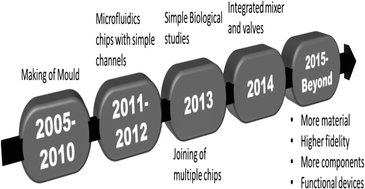3D printed microfluidics for biological applications
Abstract
The term “Lab-on-a-Chip,” is synonymous with describing microfluidic devices with biomedical applications. Even though microfluidics have been developing rapidly over the past decade, the uptake rate in biological research has been slow. This could be due to the tedious process of fabricating a chip and the absence of a “killer application” that would outperform existing traditional methods. In recent years, three dimensional (3D) printing has been drawing much interest from the research community. It has the ability to make complex structures with high resolution. Moreover, the fast building time and ease of learning has simplified the fabrication process of microfluidic devices to a single step. This could possibly aid the field of microfluidics in finding its “killer application” that will lead to its acceptance by researchers, especially in the biomedical field. In this paper, a review is carried out of how 3D printing helps to improve the fabrication of microfluidic devices, the 3D printing technologies currently used for fabrication and the future of 3D printing in the field of microfluidics.


 Please wait while we load your content...
Please wait while we load your content...